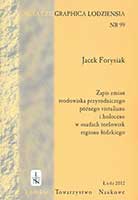Zapis zmian środowiska przyrodniczego późnego vistulianu i holocenu w osadach torfowisk regionu łódzkiego
Record of changes in the natural environment of the Late Weichselian and Holocene preserved in the sediments of peatlands of the Łódź region
Author(s): Jacek ForysiakSubject(s): Cultural Essay, Political Essay, Societal Essay
Published by: Łódzkie Towarzystwo Naukowe
Keywords: central Poland; geology and geomorphology of peatlands; telmatological studies; palaeogeography; paleoecology
Summary/Abstract: The paper presents the geological and geomorphological description of selected peatlands of the Łódź region. It also summarises the results of studies on biogenic sediments documented in their basins. The detailed study concerned 16 objects with currently functioning peat-forming vegetation assemblages. Valley peatlands prevail, and few plateau peatlands occur. Some of them occur in depressions accompanying aeolian landforms. The basins of the peatlands studied developed in the Late Weichselian and Holocene by fluvial, aeolian, slope, and thermokarst processes. Also basins of modern peatlands of glacial origin, transformed by the aforementioned processes in the Weichselian, are encountered. The thickness of the documented biogenic sediments in the profiles analysed varies from 2 to more than 12 m. Several types of gyttja and several species of peat were observed at the study sites. Sediments from selected sites were subject to palaeoecological and geochemical analyses as well as absolute datings. The analysis of the geomorphology and geological structure of peatland basins permitted the determination of the origin of the depressions in which they occur. Substantial differentiation of the study objects allowed for the distinguishing of four groups: basins located on plateaus, of glacial origin, basins of aeolian origin, basins located in dead valleys, and basins located on active river valley beds. For each of the groups of peatlands distinguished, a pattern of development of its reservoir (lake or peatland) from the origin to the contemporary stage of anthropogenic transformations was proposed, concerning all of the studied peatland of the region. Based on the biogenic sediments analysed, a description of changes in the natural environment of the Łódź region within the last dozen thousand years was prepared. The oldest sediments recorded were deposited at the end of the Upper Pleniweichselian, in the basin of the Żabieniec peatland. This peatland is the only one from all the study sites with a continuous record of environmental changes until the modern times. The Late Weichselian is represented by limnic sediments or peats deposited in almost all of the peatlands studied. Two of them include sediments correlated with the epe warming. In the Oldest Dryas, further biogenic accumulation reservoirs developed, both in the vicinity of aeolian landforms, and in river valleys. Sediments of majority of the objects analysed include a record of climatic and palaeohydrological changes of the Böllig and Alleröd, as well as the Younger Dryas. The palaeoecological and palaeogeographical image of the Holocene was obtained in biogenic sediments from sites located in all of the distinguished groups of peatland basins. Only several objects include a continuous record of changes. In the remaining ones, peat sedentation was interrupted. Peatlands developed in the basins again at the end of the Subboreal and in the Subatlantic.
Journal: Acta Geographica Lodziensia
- Issue Year: 2012
- Issue No: 099
- Page Range: 1-163
- Page Count: 163
- Language: Polish

